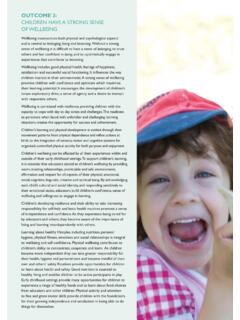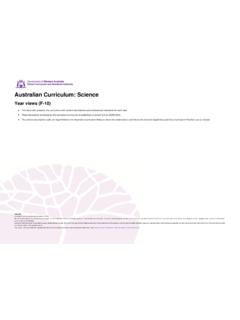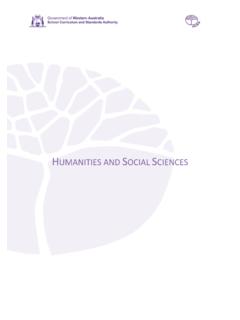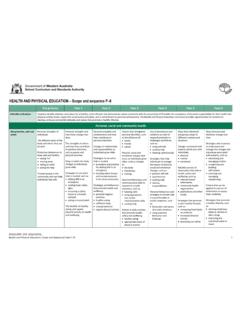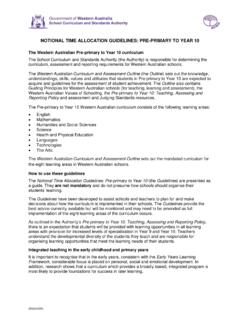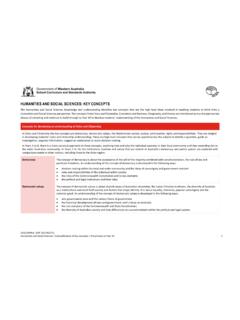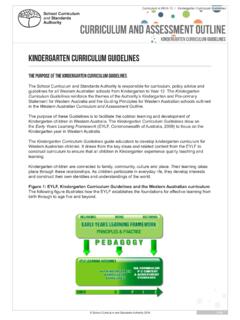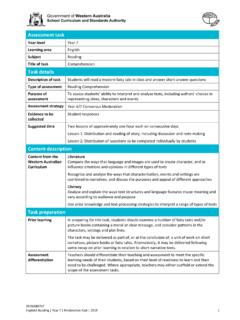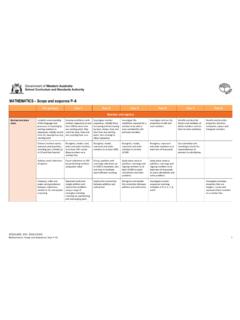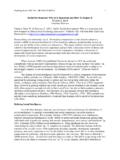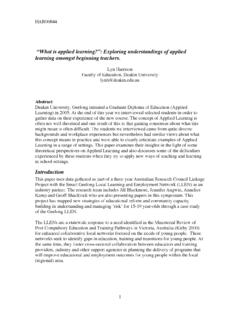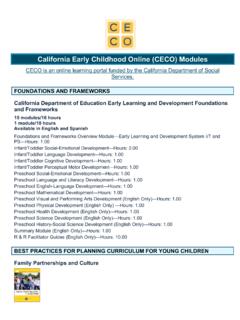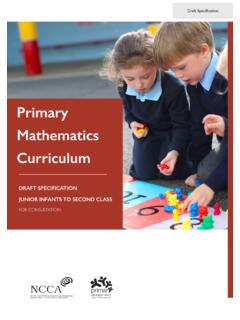Transcription of OUTCOME 5: CHILDREN ARE EFFECTIVE COMMUNICATORS
1 OUTCOME 5: CHILDREN ARE EFFECTIVE COMMUNICATORSC ommunication is crucial to belonging, being and becoming. From birth CHILDREN communicate with others using gestures, sounds, language and assisted communication. They are social beings who are intrinsically motivated to exchange ideas, thoughts, questions and feelings, and to use a range of tools and media, including music, dance and drama, to express themselves, connect with others and extend their s use of their home languages underpins their sense of identity and their conceptual development.
2 CHILDREN feel a sense of belonging when their language, interaction styles and ways of communicating are valued. They have the right to be continuing users of their home language as well as to develop competency in Standard Australian English. Literacy and numeracy capabilities are important aspects of communication and are vital for successful learning across the curriculum. Literacy is the capacity, confi dence and disposition to use language in all its forms. Literacy incorporates a range of modes of communication including music, movement, dance, story telling, visual arts, media and drama, as well as talking, listening, viewing, reading and writing.
3 Contemporary texts include electronic and print based media. In an increasingly technological world, the ability to critically analyse texts is a key component of literacy. CHILDREN benefi t from opportunities to explore their world using technologies and to develop confi dence in using digital media. Numeracy is the capacity, confi dence and disposition to use mathematics in daily life. CHILDREN bring new mathematical understandings through engaging with problem solving. It is essential that the mathematical ideas with which young CHILDREN interact are relevant and meaningful in the context of their current lives.
4 Educators require a rich mathematical vocabulary to accurately describe and explain CHILDREN s mathematical ideas and to support numeracy development. Spatial sense, structure and pattern, number, measurement, data argumentation, connections and exploring the world mathematically are the powerful mathematical ideas CHILDREN need to become in early childhood settings build on the range of experiences with language, literacy and numeracy that CHILDREN have within their families and attitudes and competencies in literacy and numeracy are essential for CHILDREN s successful learning.
5 The foundations for these competencies are built in early , BEING & BECOMING The early Years Learning Framework for Australia 39 Attuned: Attunement includes the alignment of states of mind in moments of engagement, during which affect is communicated with facial expression, vocalisations, body gestures and eye contact . (Siegel,1999) OUTCOME 5: CHILDREN ARE EFFECTIVE COMMUNICATORSC hildren interact verbally and non-verbally with others for a range of purposes CHILDREN engage with a range of texts and gain meaning from these texts CHILDREN express ideas and make meaning using a range of media CHILDREN begin to understand how symbols and pattern systems work CHILDREN use information and communication technologies to access information, investigate ideas and represent their thinkingTexts.
6 Things that we read, view and listen to and that we create in order to share meaning. Texts can be print-based, such as books, magazines and posters or screen-based, for example internet sites and DVDs. Many texts are multimodal, integrating images, written words and/or OUTCOMES40 BELONGING, BEING & BECOMING The early Years Learning Framework for AustraliaChildren interact verbally and non-verbally with others for a range of purposesThis is evident, for example, when CHILDREN :engage in enjoyable interactions using verbal and non-verbal language convey and construct messages with purpose and confi dence, building on home/family and community literacies respond verbally and non-verbally to what they see, hear, touch, feel and taste use language and representations from play, music and art to share and project meaningcontribute their ideas and experiences in play.
7 Small and large group discussions attend and give cultural cues that they are listening to and understanding what is said to themare independent COMMUNICATORS who initiate Standard Australian English and home language conversations and demonstrate the ability to meet the listeners needsinteract with others to explore ideas and concepts, clarify and challenge thinking, negotiate and share new understandings convey and construct messages with purpose and confi dence, building on literacies of home/family and the broader communityexchange ideas, feelings and understandings using language and representations in playdemonstrate an increasing understanding of measurement and number using vocabulary to describe size, length, volume, capacity and names of numbersexpress ideas and feelings and understand and respect the perspectives of othersuse language to communicate thinking about quantities to describe attributes of objects and collections.
8 And to explain mathematical ideasshow increasing knowledge, understanding and skill in conveying meaning in at least one languageEducators promote this learning, for example, when they: engage in enjoyable interactions with babies as they make and play with soundsare attuned and respond sensitively and appropriately to CHILDREN s efforts to communicate listen to and respond to CHILDREN s approximations of words value CHILDREN s linguistic heritage and with family and community members encourage the use of and acquisition of home languages and Standard Australian Englishrecognise that CHILDREN enter early childhood programs having begun to communicate and make sense of their experiences at home and in their
9 Communitiesmodel language and encourage CHILDREN to express themselves through language in a range of contexts and for a range of purposesengage in sustained communication with CHILDREN about ideas and experiences, and extend their vocabularyinclude real-life resources to promote CHILDREN s use of mathematical languageAdd your own examples from your context: OUTCOME 5: CHILDREN ARE EFFECTIVE COMMUNICATORSLEARNING OUTCOMESBELONGING, BEING & BECOMING The early Years Learning Framework for Australia 41 Literacy: in the early years literacy includes a range of modes of communication including music, movement, dance, story telling, visual arts, media and drama, as well as talking, reading and engage with a range of texts and gain meaning from these textsThis is evident, for example, when CHILDREN .
10 Listen and respond to sounds and patterns in speech, stories and rhymes in contextview and listen to printed, visual and multimedia texts and respond with relevant gestures, actions, comments and/or questions sing and chant rhymes, jingles and songs take on roles of literacy and numeracy users in their play begin to understand key literacy and numeracy concepts and processes, such as the sounds of language, letter-sound relationships, concepts of print and the ways that texts are structuredexplore texts from a range of different perspectives and begin to analyse the meaningsactively use, engage with and share the enjoyment of language and texts in a range of waysrecognise and engage with written and oral culturally constructed textsEducators promote this learning, for example, when they.
